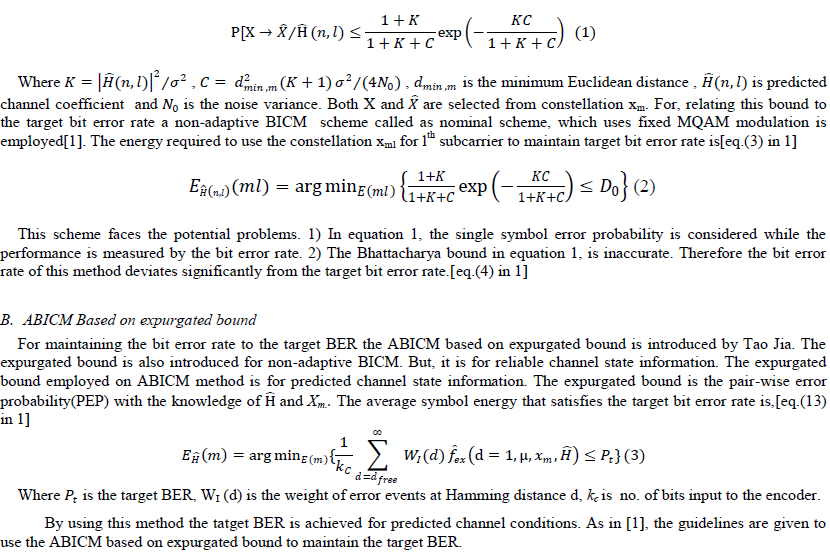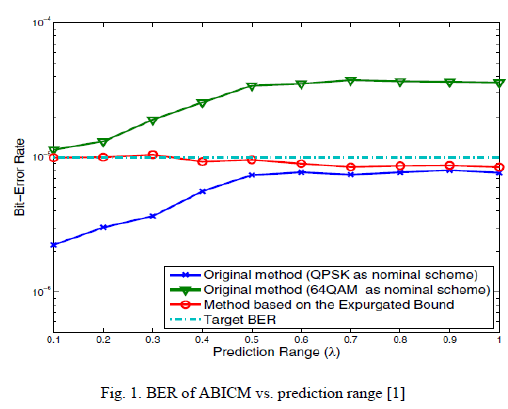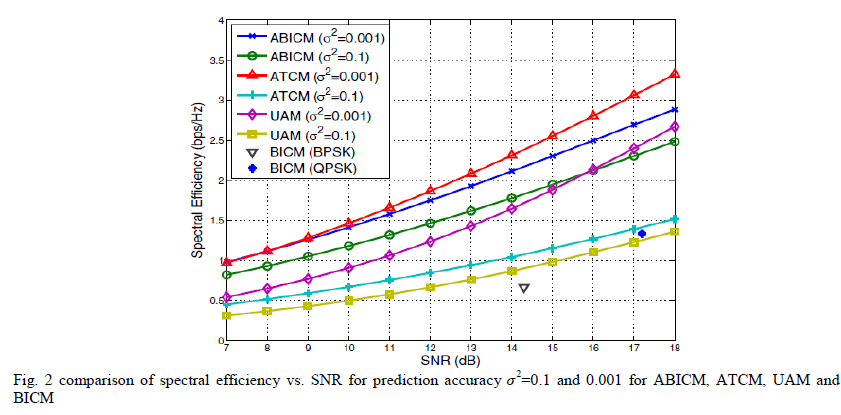ISSN ONLINE(2278-8875) PRINT (2320-3765)
ISSN ONLINE(2278-8875) PRINT (2320-3765)
| P.M.Wagh, P. H. Zope, S. R. Suralkar Department of Electronics and telecommunication, SSBT’s College of Engineering and Technology, Bambhori, Jalgaon, Maharashtra, India |
| Corresponding Author: SHARMA VIVEK, E-mail: vivek03sharma@rediffmail.com |
| Related article at Pubmed, Scholar Google |
Visit for more related articles at International Journal of Advanced Research in Electrical, Electronics and Instrumentation Engineering
This paper investigates different methods for improving accuracy of bit error rate.It also improves spectral efficiency for mobile radio OFDM systems with the use of fading prediction.A comprehensive list of references is reported and comparisons of various methods such as UAM, ATCM, BICM &ABICM is reported.ABICM method based on expurgated bound proves the better performance for maintaining bit error rate(BER) compared to ABICM method based on Bhattacharya bound.A long range fading prediction (LRP) is very useful for maintaining reliability of channel state information(CSI). By combining the effect of fading prediction and expurgated bound for adaptive bit interleaved coded modulation the performance of spectral efficiency improves for both reliable and unreliable CSI conditions.
Keywords |
| Channel state information, long range prediction, Trellis coded modulation, orthogonal frequency division multiplexing (OFDM). |
INTRODUCTION |
| Nowadays, increasing demand of wireless communication industry necessitates the techniques which facilitates the efficient and improved communication which solves all the possible technical challenges to maintain the quality of wireless link .As the signal propagates through the mobile radio channels,it experiences random fluctuations in both time and frequency domain due to rapidly varying channel conditions. For mobile communication systems, where the channel is varying with respect to time it becomes essential to predict the information about channel state referred to as “channel state information(CSI)” for maintaining the efficiency of wireless link. The estimation about CSI is done due to the fact that there is always time difference between the time that the channel is measured and the time the corresponding transmission is made. Depending on the predicted channel condition the transmitter selects the appropriate modulation and transmission parameters. This process is known as “Adaptation”. When the adaptation decision is made by the transmitter the receiver needs to be informed about the selected transmission parameters and vice versa. This method is referred as CSI feedback. This above mentioned steps 1.Prediction 2.adaptation 3.CSI feedback is essential for maintaining reliability of CSI [2]. |
| The adaptive bit interleaved coded modulation (ABICM) was proposed in [1] is based on expurgated bound aided by fading prediction. This method improves the accuracy of bit error rate (BER) compared to the original ABICM method proposed in [3].The original ABICM method [3] is based on Bhattacharyabound. The Bhattacharya bound is based on minimum distance of constellation and a nominal non-adaptive BICM scheme were employed to determine the constellation size and the transmission power. By using the original ABICM method the bit error rate deviates significantly than the actual bit error rate. Therefore, ABICM method based on expurgated bound is employed for mobile radio OFDM systems for its improved performance. |
| The ABICM also gives better spectral efficiency comparing to the methods that are proposed in last 20 years. The adaptive trellis coded modulation (ATCM) gives the better performance of spectral efficiency for reliable CSI but as the CSI becomes outdate the performance of ATCM decays very sharply. Thus, ATCM does not comprise a better performance for unreliable CSI.ATCM is also more sensitive to prediction errors than uncoded adaptive modulation (UAM) techniques. The UAM technique was investigated before the adaptive trellis coded modulation (ATCM) .Hayes proposed the adaptation of transmission power when the channel quality varies but the drawback of this approach is it increases the peak power of interference to other users. To improve system capacity the trellis code was proposed on adaptive modulation. But this scheme achieves coding gain in the fading channel only when the CSI is accurate[2]. |
| Zehavi recognised that reliability and code diversity of coded modulation (CM) over a Rayleigh fading channel can be improved by introducing bit wise interleaving at the encoder output and appropriate soft decision bit metric as an input to the Viterbi decoder. This technique is known as bit interleaved coded modulation (BICM).The interleaving is introduced to minimise the error probability .BICM is more robust to prediction errors than the trellis coded modulation (TCM).The time diversity of systems operating over fading channels can be improved by using BICM by providing an independent fading component for each channel bit out of the convolutional encoder as oppose to each channel symbol [3]. Due to the fact that non adaptive BICM is more robust to prediction errors than non adaptive TCM techniques.Thus the adaptation of BICM systems is more effective than adaptation of TCM techniques for analysing the performance of bit error rate (BER).The ABICM method is thus introduced to maintain the performance of bit error rate (BER). |
| This paper is organised as follows- section II discussed the overview of different adaptive modulation methods. In Section III, the ABICM method based on Bhattacharya bound and expurgated bound discussed. Section IV compares different methods based on BER and spectral efficiency. Section V concludes the paper followed by the references. |
HISTORY AND OVERVIEW |
| In this section we recall the techniques which are investigated before the ABICM method . |
| A. Adaptive trellis coded modulation (ATCM) |
| In 1982, Ungerboeck published his landmark paper on Trellis coded modulation (TCM) in which he recognised that modulation and coding should be combined in a single entity for improving performance. In trellis coded modulation the trellis code are employed with modulation.The trellis code also referred as convolutional codes. TCM uses many diverse concepts from signal processing. In Trellis coded modulation, the word “Trellis” stands for convolution codes. In communication link modulation and coding are the two different aspects but in TCM both are combined for improving performance. In, Adaptive Trellis coded modulation, convolutional encoder is used at the rate of k/(k+1, where k is number of input bits to the convolutional encoder and ( k+1) is the output bits of convolution encoder. For modulation, different modulation techniques such as MPSK, MQAM or MASK are used and a m-ary signal mapper is used as modulator that maps M=2k input points into a large constellation of M=2k+1 constellation points. |
| Adaptive trellis Coded Modulation achieves better spectral efficiency only when the prediction accuracy is good. That means it gives better results only when the CSI (channel state information) is accurate. But when the CSI is inaccurate the performance of ATCM technique degrades very rapidly. ATCM is more sensitive to prediction errors than Uncoded adaptive modulation (UAM) technique. In Uncoded adaptive modulation (UAM), the adaptation of transmission power is done when the channel quality varies. But the drawback of this approach is that it increases the peak power of transmission of interference to other users. |
| B. Bit interleaved Coded Modulation (BICM) |
| In 1992, Zehavi introduced the bit interleaved coded modulation for improving reliability of coded modulation over a Rayleigh fading channel . Zehavi’s idea was to make the code diversity equal to the smallest number of distinct bits(rather than channel symbols) along any other error event. And this can be achieved by bit-wise interleaving at the encoder output, and by using an appropriate soft decision bit metric as an input to the Viterbi decoder[5]. The Bit Interleaved Coded Modulation (BICM) system uses a Non-recursive non-Systematic Convolutional (NSC) code whose bits are interleaved (interleaver length is M) and then mapped to complex symbols (L QAM modulation is used). Channel capacity is increased by using higher order modulations. Gray and binary mapping (following Matlab's terminology) are used. The channel is assumed flat fading, defined only by an attenuation. The attenuations are generated from a complex Gaussian distribution with variance 1/2 on each dimension. The received signal is affected by an Additive White Gaussian Noise (AWGN). |
| Due to the bit-wise interleaving the probability of errors is reduced. BICM is more robust to prediction error than TCM for analysing the performance of bit error rate. Though it gives better performance still the adaptive signalling is necessary along with the bit interleaved coded modulation. |
| C. Adaptive Bit interleaved Coded Modulation (ABICM ) |
| In 2001, Ormeci investigated about the Adaptive Bit Interleaved Coded modulation systems for achieving the target bit error rate. The Adaptive bit interleaved coded modulation schemes remove the need for parallel branches in the Trellis even when Adapting the constellation size, thus making thus schemes robust to prediction errors which are made in analysing channel state information[3]. Due to employing interleaving the ABICM is much less sensitive to the prediction errors compared to the adaptive modulation techniques that do not employ interleaving. But for the practical channel conditions (In case of mobile channels) reliable fading prediction is necessary for achieving the higher spectral efficiency. |
ABICM FOR PRACTICAL CHANNELS |
| A. Original ABICM Method |
| The original ABICM Method, which uses Bhattacharya Bound for single symbol error probability. The Bhattacharya bound of this error probability is[2,3] |
 |
COMPARISON |
| A. Based on BER |
| Fig. 1 shows the graph of bit error rate vs. prediction range(λ) for the SNR=15dB. It gives comparison of original ABICM Method and the ABICM Based on the expurgated bound. For original ABICM Method, the two nominal schemes namely QPSK and 64-QAM is used.by QPSK as a nominal scheme the BER of ABICM decreases from target BER and by using 64-QAM as a nominal scheme the BER of ABICM increases from target BER. While the method Based on the expurgated bound maintains the BER very close to the target BER. |
 |
| B. Based on spectral efficiency |
| Fig. 2 gives the comparison of spectral efficiency vs. SNR for prediction accuracies σ2=0.1 and 0.001. Where σ2=0.1 means inaccurate CSI or unreliable CSI and σ2=0.001 means accurate CSI or reliable CSI. σ2 is the prediction accuracy which decides the reliability of CSI. Fig.2 gives the spectral efficiency of different methods i.e. ABICM, ATCM, UAM and BICM for different prediction accuracies. The BICM and UAM gives the poor performance while ATCM gives the better performance only when the CSI is reliable. The ABICM Method gives the better performance for both the conditions. |
 |
CONCLUSION |
| The new ABICM Method based on expurgated bound achieves higher spectral efficiency. This method also maintains the accuracy of bit error rate. As reported by included references it can be concluded that ABICM based on expurgated bound is best suitable method for practical channel conditions. ABICM is also much less sensitive to prediction errors compared to the other adaptive modulation techniques. |
References |
|